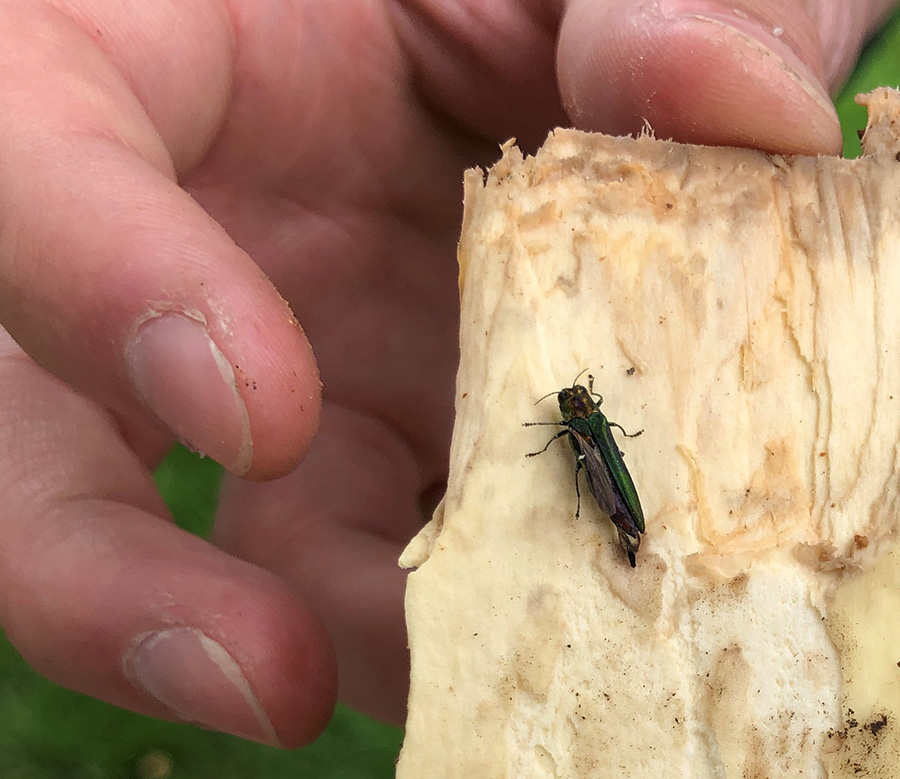By James Day
The emerald ash borer (EAB), a forest pest that has been targeting ash trees in the United States since 2002, has been found in Oregon.
An infestation discovered June 30 in Forest Grove means that concerns of state and local officials about the ash borer’s impact on urban forests, wetlands and streams has gone from the hypothetical to the here and now.
“Since it was first found in the Detroit, Michigan, area back in 2002, EAB has become the most destructive and costliest forest pest ever to invade North America,” said Wyatt Williams, an invasive species specialist in the Oregon Department of Forestry.

“This little insect (it’s only half an inch long and an eighth of an inch wide) has spread to 35 states and five Canadian provinces, killing up to 99 percent of the ash trees in some locations. At least five ash species native to the central U.S. have become critically endangered as EAB spreads across the country killing hundreds of millions of urban and wild ash trees.”
Within a decade of EAB’s arrival in an area, most ash trees are dead or dying. The concern in Oregon is for Oregon ash because of the important ecological role the native species plays along streams and in wetlands. Ash trees are also frequently used as street trees.
“It’s an ecologically vital tree as it shades water, keeping it cooler for fish,” Williams said. “The roots stabilize streambanks, reducing erosion. And lots of animals, birds and insects eat the seeds and leaves. Losing it will likely have a huge impact on those ecosystems.”
The good news is that because the arrival of the pest became public knowledge in 2002 there was time for Oregon officials to plan a response. In fact, a 79-page “readiness and response plan” was completed in March of 2021.
The bad news is that there are not a lot of good solutions out there. Traps are only partially effective, pesticides are costly (and come with baggage and challenges of their own) and biological controls such as introducing a natural enemy of the EAB remain a work in progress.
Silverton plans to create a committee to work on EAB issues and other city tree matters. A resolution authorizing the committee will be on the agenda at the City Council’s Sept. 12 meeting.
The committee, said City Manager Ron Chandler, will focus on providing advice on the city’s street tree list, on environmental dangers such as the ash borer, on urban reforestation and the city’s Tree USA designation.
The impetus to form the committee started with public testimony at the July 11 meeting from retired nursery man Eric Hammond.
“We don’t have to do anything right away,” Hammond told Our Town on a visit to Town Square Park, which includes ash trees. “We just need to monitor it and pay attention. It’s a keystone species because of the quantity and the other life – insects and birds – that lives in there.”
One key effort that Williams and other Oregon officials have been advocating is the harvesting and preservation of ash seeds.
“The first goal is to try and preserve as much of the tree’s genetic diversity as we can before it’s lost,” Williams said. The U.S. Forest Service’s Dorena Genetics Resource Center in Cottage Grove stores the ash seeds and is sharing them with researchers.
“The researchers will test for any resistance to EAB. If any is found, we might then be able to breed resistance into local strains and replant streambanks,” Williams said.
Scott Altenhoff, ODF’s urban and community forestry assistance program manager, advises cities and towns to do three things.
“First, if it hasn’t been done already, inventory trees to see how vulnerable the local urban forest is to losses from emerald ash borer.” Altenhoff said. “Second, now is a good time to remove ash trees from approved street tree lists as has been done in Portland. Finally, consider how wood from ash trees that die from emerald ash borer might be used locally.”
But Altenhoff and other state officials strongly caution that ash should not be moved beyond the local area. That avoids people accidentally spreading wood-boring pests faster than they would otherwise.
Altenhoff also advises communities to prioritize removal of ash trees that are already in poor health or growing in spaces too small for them.
About the borer
The pest: Emerald ash borer (Agrilus planipennis Fairmaire)
The problem: It has killed more than 100 million ash trees in the United States and caused $2 billion in damage
The source: The EAB is a native of eastern Asia (Russia, China, Mongolia, Japan and the Korean Peninsula)
The history: In 2002, likely through international shipping of infested wood product materials such as pallets in the Great Lakes area.
The casualties: Five eastern ash species – green, white, black, blue and pumpkin – already are listed as critically endangered.
How it works: Eggs laid in crevices of bark hatch and the larvae consume the inner phloem, cambium and outer xylem just beneath the bark. The feeding cuts off the flow of sugars from the leaves to the roots, effectively starving the trees.
Source: Oregon Department of Forestry
_____
Resources to report or review
• To report sightings of emerald ash borer make a report online at the Oregon Invasive Species Council hotline, https://oregoninvasiveshotline.org/reports/create or call 1-866-invader.
• To view the state’s plan for EAB go to https://www.oregoninvasivespeciescouncil.org/eab?rq=emerald%20ash%20borer
• For more information about the impacts of EAB on Oregon’s urban forests and the risks to native ash trees visit ODF’s forest health page at https://www.oregon.gov/odf/forestbenefits/pages/foresthealth.aspx